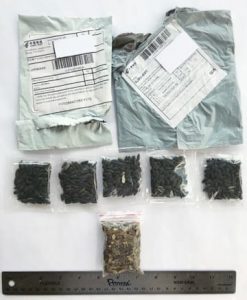Blog by Morgan Pinkerton and Tina McIntyre, UF/IFAS Extension Seminole County
How can invasive weeds spread?
Plants can’t just get up and walk like we can, so how do they move to new locations?

First, we should talk about plant reproduction and natural dispersal. Many plants make seeds to reproduce, but this is also how they can disperse. You may have even watched this dispersal in action if you have ever seen the wind blow dandelion seeds. Maybe you even made a wish and blew them into the wind yourself! In addition, some plants reproduce vegetatively through pieces of the stems, roots or leaves.
More often than not, humans help spread invasive species long distances. This can be unintentional or on purpose. Today, we live in a highly globalized society with people and products moving across the world. However, this also leads to the increased movement of invasive species. Unintentionally, plants or seeds can hitchhike on the stuff we are moving around. For example, invasive weeds can be hiding in cargo and inadvertently transported to new locations. On the other hand, the invasive species might have been intentionally introduced and moved around because of trade. This is commonly seen with ornamental plants because they are pretty and people want to buy them.
What can you do to stop the movement of invasive weeds?
- Avoid planting or moving invasive species. Don’t be part of the problem and learn about your plants prior to purchasing or planting. Stores might sell plants that are non-native and some are potentially invasive species.

Suspicious seed packets received by US citizens in the mail in 2020; Photo: Kentucky Department of Agriculture - Buy seeds and plants from trusted sources. Seed packets can sometimes have other seeds mixed in them. Make sure you purchase your seeds from trusted sources so that there are not any invasive weed seeds mixed in. Likewise, potted plants might have invasive weeds or seeds hiding out in them too.
- Chose native plants when possible. Native plants have many benefits on the local ecosystem. Try to chose native alternatives to invasive species.
- Check for hitchhikers. Plants and seeds can stick to shoes, clothes, equipment and other objects. Check to make sure you don’t have hitchhikers on yourself, pets or other objects before moving to new locations, especially if you have been outdoors.
- Get educated on invasive species in your local area. Find out what invasive weeds are of a concern in your area and keep up with the news on efforts surrounding detection, eradication, or management.

Hydrilla hitchhiking on a boat motor, Photo Credit: Wilfredo Robles, Mississippi State University, Bugwood.org - Participate in invasive weed clean ups (Hint: Weed Wrangle Week). Sometimes the most effective way to remove invasive weeds is good old fashion hard work getting your hands dirty. Annually, there are lots of volunteer events to help remove invasive weeds including the Weed Wrangle© Week efforts.
- Remove invasive species. If you have a known invasive species, remove that plant. If possible, remove the plant before it produces seeds.
- Submit suspect samples. Many invasive species go unnoticed until it is too late to do anything to get rid of them. You can report suspect new invasive species to help be an early detector of the problem. Your local extension office is a great starting point and they can point you to the right direction for who to contact.
Interested in participating in Weed Wrangle© Week 2021?
Check out this article for more information on what is going on locally this week. Be sure to catch all the other cool resources we are sharing this week on our Central Florida CISMA Facebook page!
More Resources
- Central Florida Cooperative Invasive Species Management Area
- Florida Invasive Species Partnership
- Florida First Detector Program
- Invasive Weeds EDIS Documents
- UF Center for Aquatic and Invasive Plants
- WeedWrangle.org
 0
0


